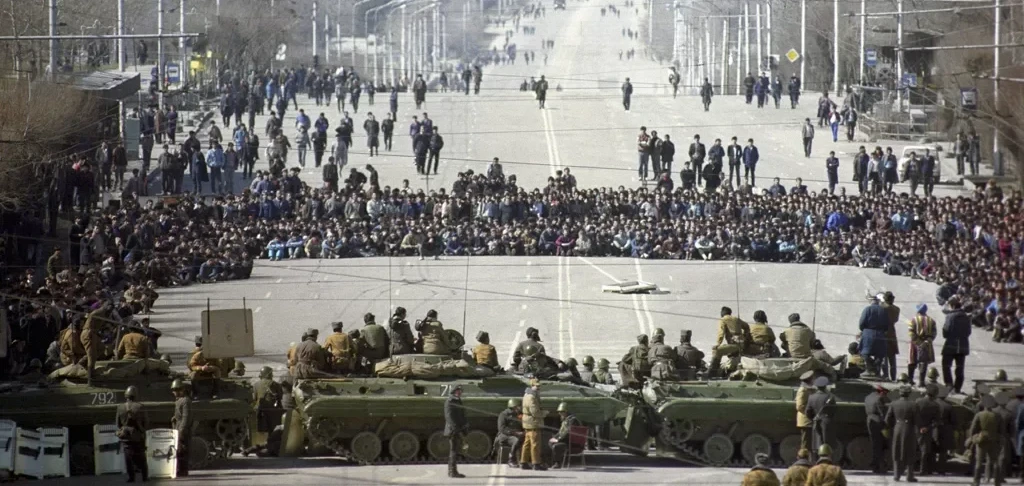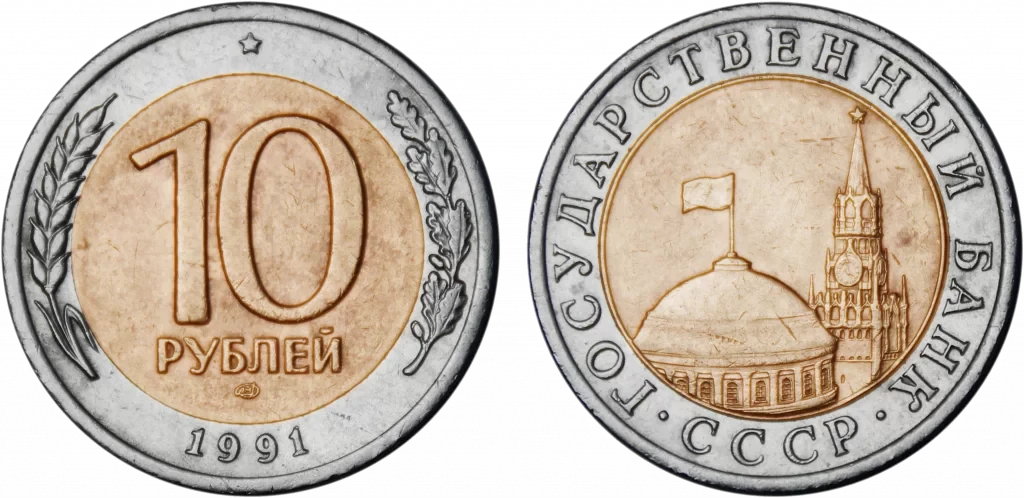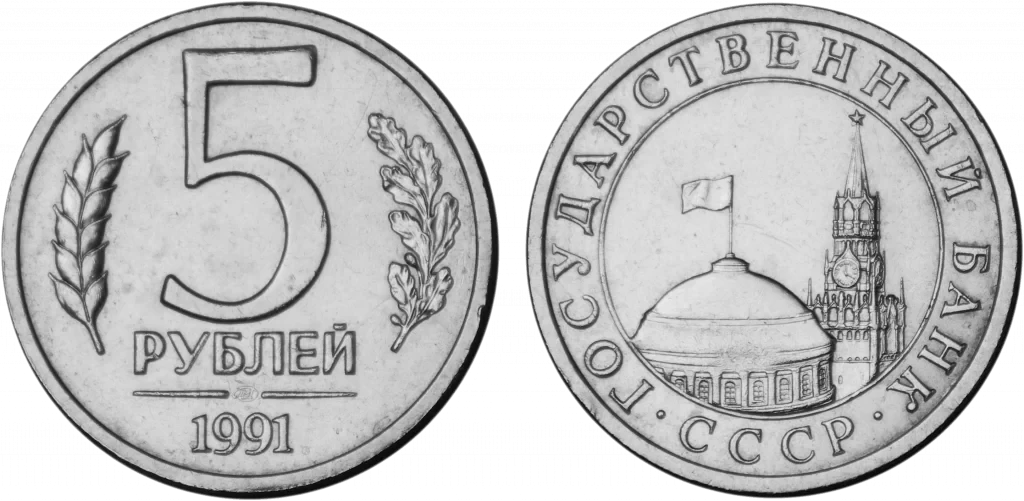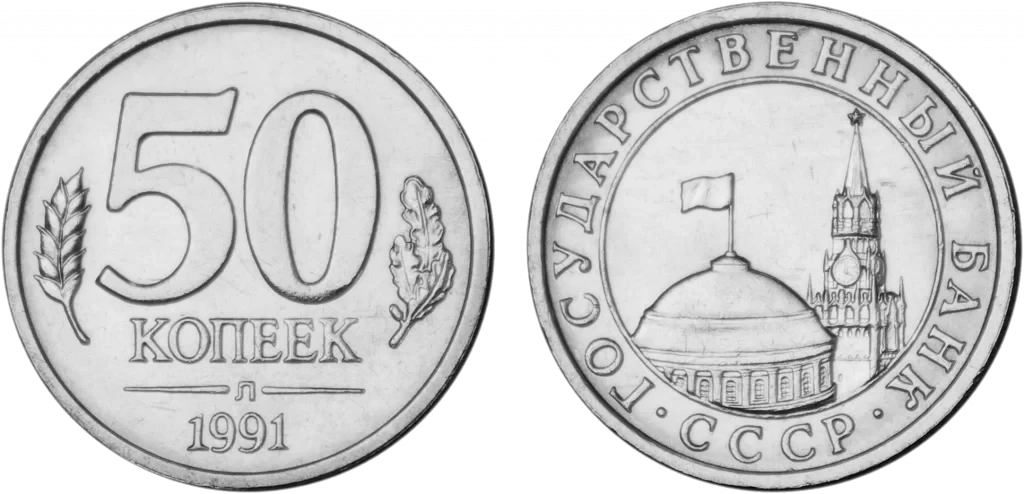On December 25, 1991, at 7:32 pm, the flag of the hammer and sickle was lowered for the last time in the Kremlin. In everyone’s eyes, that was the moment when the Soviet Union died. Which is quite ironic, as the flag in the Kremlin was going to be the great propaganda symbol in the new coins that were going to be introduced in 1991 and that ended up being the very last coins of the Soviet Union.
A really, really unstable situation
The political landscape of the Soviet Union between 1988 and 1991 was, to put it mildly, quite unstable.

In addition to independence movements in the Baltic states, Eastern Europe, and the Caucasus, the failed democratization advocated by Gorbachev, and the breakdown of the tight information sphere controlled by the Communist Party, the USSR was facing an unprecedented economic crisis.
With the prices of essential goods rising an average of 300%, and people queuing up to buy what little food remained in stores, the Soviet government had to resort to foreign aid.
It got to the point where the term “Bush legs” was commonplace in the Soviet citizen’s language, referring to the chicken legs that the United States was sending as part of one of the trade agreements that the USSR had reached to try to alleviate the situation.
Gorbachev knew he had to do something. So he called upon an economic bureaucrat, one Valentin Pavlov, to become Prime Minister of the Soviet Union and take a series of measures to stabilize the economic situation.

And, following the traditional Russian style manual of political communication to a T, the first thing Pavlov did was to tell Soviet citizens that there would be no economic reform. The second? Well, of course, design his economic reform.
His first measure was a confiscatory monetary reform, carried out on February 23, 1991. With it, the two highest denomination banknotes, the 50 and 100 ruble notes from 1967, were replaced with redesigned 50 and 100 ruble notes.
The problem?
Soviet citizens would only have three days to exchange them at the bank, and only up to a maximum amount of 1000 rubles. And, from that moment on, there would also be a restriction on bank withdrawals, with only up to 500 rubles per month allowed.

The goal was to withdraw 81 billion rubles from circulation and thus reduce inflation. In reality, what Pavlov achieved was to destroy the savings of a large part of the population (but not for the richer and better connected, who had prior notice of the reform and were able to exchange their money before it was announced to the general population).
The streets and bonfires of Moscow, Kyiv, Vladivostok, and Tallinn were filled with shattered dreams and bills that were no longer worth anything.

The measure was a failure: only 14 billion rubles were withdrawn from circulation. On top of that, inflation after the reform increased even further, reaching an annual rate of 164.7%, while GDP fell between 20% and 30%.
And, at that moment, the Soviet republics stopped sending tax money to the government in Moscow, sending the central economy into a coma.
All of this is to say that there was a citizenry that no longer trusts its currency, a government in rampant economic crisis, and runaway inflation. What any country in the world would do in that situation is to change the currency.
And that is -sort of- what the Soviet Union did.
The Last Coin Series of the Soviet Union
During the crisis, the circulating coins of the Soviet Union, the ones used for everyday transactions, were ugly and outdated, a product of a bygone era. They had been in circulation since 1961 with few changes, and no longer reflected the country’s political atmosphere.

In addition, due to a rather complicated monetary system that included coins such as the 3-kopek (cents of a ruble) or the 15-kopek coin shown above, certain monetary transactions were quite difficult.
By redesigning the currency, the monetary system was simplified, with only 10- and 50-kopek coins and 1, 5, and 10-ruble coins in circulation.

The new coins also featured certain technological innovations. For example, for the first time, bimetallic coins appeared in the USSR currency.

The designers also seemed to have taken into account the country’s political situation, in which the republics were gaining more and more autonomy (some had even already declared independence) from the Kremlin’s central power.

This led to the disappearance of the Soviet Union’s coat of arms on the coins, but the propaganda of Moscow as the center of power did not disappear. After all, historically, coins are the strongest transmitter of propaganda.

Instead of the coat of arms, the coin designers chose a view of the Kremlin with the dome of the Senate Palace, over which a generic flag waved, and the Spasskaya Tower, the main tower on the eastern wall, the one that faces the Red Square.

The name of the Soviet Union as the issuer also disappeared, and the State Bank of the Soviet Union (Gosbank), which served as the central bank for all the republics, appeared as the issuer instead.
These coins were put into circulation shortly after the August 1991 coup d’état led by hardcore, old school communists, with the aim of ousting Gorbachev from power. The coup plotters identified themselves as the State Committee on the State of Emergency, better known as the GKChP, after their initials in Russian.
The population associated the coins with the committee because…Pavlov, who was responsible for monetary reforms, was one of the coup plotters. Today, in Russia, these coins are known as the GKChP coins.
So where’s the irony?
These coins were meant to symbolize a new era in the Soviet Union. A new age in which Glasnost and Perestroika were supposed to lead to prosperity, freedom, and technological advancement in the Union, which would now be a group of autonomous republics under Moscow’s leadership.
Hence the symbolism of the Kremlin as the center of power and the disappearance of Soviet Union symbols.
And yet, the design of these new coins would end up portraying what eventually became the great visual symbol of the fall of the Soviet Union on December 25, 1991: the removal of the red flag from the Kremlin.
Today, finding the last series of Soviet Union coins is not very complicated. Given the short time they circulated, they are easy to find in an excellent conservation state, and you can get all five coins for less than 20 bucks.
By the way, the USSR even managed to issue two commemorative circulating coins featuring endangered animals, based on the bi-metallic 10 rubles. They are relatively rare and expensive nowadays. And there is also a 10 ruble coin from 1992, the year after the fall of the Soviet Union. We’ll talk about them another day.